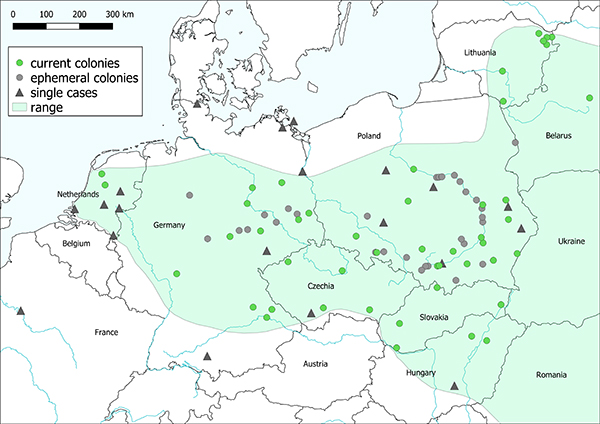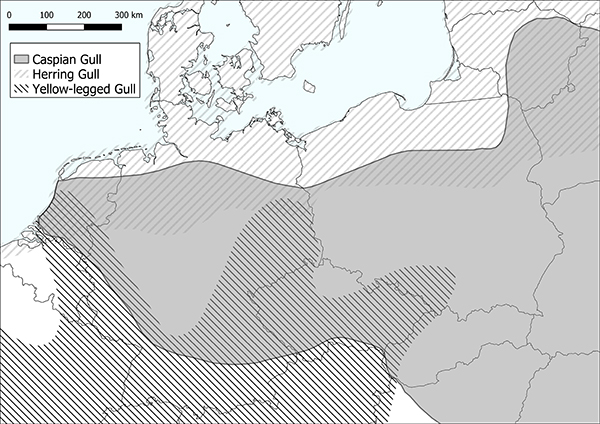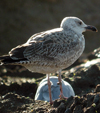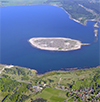 Larus cachinnans in the Netherlands
Larus cachinnans in the Netherlands
(last update: December 17, 2025)
Albert de Jong
Leon Kelder
Roland-Jan Buijs
Thijs Horst
Merijn Loeve
Mars Muusse
Cachinnans - international population trend
| you can participate in this project too! please send in your observations of colour ringed birds to: ring@buijsecoconsult.nl |

Fig. 1 Distribution of Caspian Gull in 2020 (not every colony is on the map).
Breeding range expansion of Caspian Gull in Europe: a 2021 update
Klaudia Litwiniak, Marcin Przymencki, Albert de Jong
Short version below, full paper in: British Birds June 2021 – vol. 114, issue 6, pp 331–340
Abstract
The population in nine countries (Poland, Germany, Belarus, Czechia, Slovakia, Hungary, Lithuania, The Netherlands, and France) is estimated at min. 7600 breeding pairs in the years 2018-2020. In the near future settlement is expected in a few other countries too, like Britain or Belgium. New contact zones will arise with Herring, Lesser Black-backed, and Yellow-legged, which may lead to interspecific gene flows.
Introduction
At the start of the 20th century, the breeding range of Caspian Gull Larus cachinnans (Pallas 1811) extended from Lake Saisan and lake Balkash in Kazakhstan in the east to the northern coast of the Black Sea in the west. The western population of cachinnans has increased significantly over the past century, resulting in range expansion to the north and west (Neubauer et al. 2007). New breeding sites were established along large rivers in Russia (Volga) and Ukraine (Dnepr, Dnestr). The species arrived in the Moscow area in the 1960s (Jonsson 1998 in: Panov & Monzikov 1999), and reached west-central Ukraine around 1989 (Gorban 1992). In the 1980s, a breeding population was established along the Vistula River in east-central Poland (Bukaciński et al. 1989, Walasz & Mielczarek 1992).
After 1990 the species settled in several other countries in Western Europe, expanding its breeding range into Lithuania in the north and The Netherlands in the west in recent years. This created new contact zones with other large gull species, e.g. Yellow-Legged Gull Larus michahellis, Herring Gull Larus argentatus and Lesser Black-backed Gull Larus fuscus, leading to interspecific gene flows (Neubauer et al. 2006, Gay et al. 2007).
Factors determining range expansion
Two mechanisms may have set in train range expansion. First, high productivity occured in the heartcore population leading to dispersal, emigration and new settlements at the edges of the range or even beyond that (Pulliam 1988). And second, individuals at the edge of the area may adapt to new local conditions or habitat changes, becoming very productive and subsequently become a new core (Skórka et al. 2005).
It has been demonstrated that the availability of anthropogenic food resources may be an important factor improving winter survival and higher breeding success of some gulls (Bergman 1982; Wells 1994; Pons & Migot 1995; Oro et al. 1999; Bertellotti & Yorio 2000). On the other hand, the availability of fish – their basic food resource in some areas – may constitute the key factor responsible for high reproductive performance and in consequence, successful colonisation of inland areas by these birds (Hüppop and Hüppop 1999; Skórka et al. 2005; Gwiazda et al. 2015). Fish is the most important food for Caspian Gulls breeding in south Poland (Skórka et al. 2005; Gwiazda et al. 2011; authors’ observations). Hüppop and Hüppop (1999) also suggested that inland breeding distribution of large gulls in Central Europe is limited by the availability of fish during the breeding season rather than the availability of food at refuse sites. However, when most gull species have stopped colonization and populations are established, Caspian Gull still reaches new areas (Fig. 1).
Range expansion in Central and Western Europe
| Table 1. Estimated breeding pairs Caspian Gull in Central and Western Europe. | ||
| Country | Year | Breeding pairs |
| Poland | 2019 | 3000–3500 |
| Germany | 2019 | 750–1000 |
| Czechia | 2020 | 253–259 |
| Slovakia | 2019 | 757–765 |
| Hungary | 2019 | 100–160 |
| Lithuania | 2020 | 700–800 |
| The Netherlands | 2020 | 42–45 |
| France | 2018 | 1 |
| Belarus | 2018 | >2000 |
| Minimum total | 2018–2020 | >7600 |
Poland
First breeding pairs were recorded in 1981-1982 in the Middle Vistula (Bukaciński et al. 1989, Dubois et al. 1990), but true colonization of fishponds and dam reservoirs started in the late 1990s (Neubauer et al. 2006). The population reached over 500 pairs in 2005 (Skórka et al. 2005; Neubauer et al. 2006), 1400–1500 pairs in 2011 (Chodkiewicz et al. 2015), and the population estimated 2000-3000 pairs in 2013–2018 (Chodkiewicz et al. 2019).
Currently, there are more than 15 permanent breeding colonies, including the largest one near Zastów Karczmiski (middle Vistula) with 1502 pairs in 2019 (Ł. Bednarz – pers. comm.). Some colonies exist already 20 years (Pola et al. 1998, Litwiniak et al. 2020), but there are also few small colonies, like in middle part of Vistula River (Keller et al. 2017). The total population estimated 3000-3500 by 2019, and provisional counts for 2021 estimate the Polish population at 5000 pairs (Tab. 1).
We have a separate webpage for cachinnans breeding in Poland.
Germany
Breeding Caspian Gulls were first recorded in the second half of 1980s in the eastern part of the country (Brandenburg, but later also Thuringia, Saxony-Anhalt, Mecklenburg-Vorpommern and Saxony). In 2015 the first breeding record was documented in Berlin in a roof-top colony in the city centre (Kormannshaus & Steiof 2015). In 2016, nesting Caspian Gulls were recorded in Bavaria (Tautz & Krätzel 2016). In Hessen (W Germany) the first nest was noted in 2010, a mixed pair with Yellow-legged Gull. In 2015 and 2016 there were two breeding attempts of ‘pure’ pairs breeding, both successful, in the roof-top colony in Frankfurt am Main. Also here, a mixed pair of Caspian and Lesser Black-backed Gull L. fuscus bred in 2019 (I. Rösler – pers. comm.). In the same year a ‘pure’ pair nested on roof-top in the city of Greifswald at Baltic coast (S. Piro – pers. comm.) and in Flensburg near the Danish border (R. Klein – pers. comm.).
Also two mixed pairs were found in the Herring Gulls colony on the island Greifswalder Oie at the Baltic Sea then (R. Klein, S. Piro – pers. comm.). It is very well possible that there are more Caspian Gulls breeding in Herring Gull colonies at the Baltic coast, which remain undetected (R. Klein – pers. comm.).
Major part of the population still breeds in Brandenburg, Saxony and Saxony-Anhalt, often in mixed colonies, like in Gräbendorfer See, near Laußig and Braunsbedra. In 2019 the population estimated 750 breeding pairs in the whole country (Gerlach et al. 2019). However, this estimation might be low, and closer to 1000 pairs. The population is still growing (R. Klein – pers. comm.).
Belarus
The first record of breeding Caspian Gull date from 1989, in the southern part of the country (Yakovets & Nikiforov 2009). By 1995 small numbers bred at almost all reservoirs in the vicinity of fishponds in the south (Yurko 1999). By 2018, the largest roof-top colony in Gatovo near Minsk, accounts for over 4000 pairs of large gulls Larus ssp. and more than half of the birds are Caspian Gulls or mixed pairs with Herring Gulls (Samusenko et al. 2019). Furthermore, islets in reservoirs, fishponds, and, apart from the vast Minsk colony, more urban colonies exist. These are not monitored, but are likely range between just a few pairs up to some hundreds of pairs. (I. Samusenko - pers. comm). The abundance map in the European Breeding Bird Atlas 2 mentions approximately 1700–17000 breeding pairs in the country (Keller et al 2020); unfortunately, more precise numbers are not known.
Czech Republic
The first breeding attempt in Czech Republic was in 1990 at Nové Mlýny II reservoir (south of Brno), and this location holds a serious colony since 1996. In 2019 the population of the whole country estimated 220–225 breeding pairs, and 253–259 in 2020. The largest colony (ca. 210 pairs) is still at Nové Mlýny II reservoir, but another four smaller colonies exist, with 1–30 pairs nest (M. Jelinek – pers. comm.).
Slovakia
First successful nesting was observed in 1989 at Sĺňava dam reservoir in the western part of the country and regular breeding started in 1993. In 2019, a total 757–765 pairs were breeding in four colonies, with the biggest one at Orava Reservoir with 690 pairs (R. Kvetko – pers. comm.).
Hungary
In 1996 the first nest was found at Fehér Lake, near Gátér followed by one in 1997 in Hortobágy (Ecsedi 2004). Since 2003 the species is a regular breeder in Hortobágy Fishponds (Hadarics & Zalai 2008). The last few years it also breeds on a gravel pit near Nyékládháza. The population estimated 100–160 pairs in 2019 (P. Szinai – pers. comm.).
Lithuania
Herring Gulls started to breed in Lithuania in 1982 and subsequently expanded their range to inland lakes. In early 2000s, Caspian Gulls entered these colonies as well. First reports of adult birds date from 2007 at Lake Kretuonas, but settlement here may have started already in 2003. In 2009, this lake held 160 pairs of large gulls, of which 40–50% were identified as Caspian Gulls. Numbers increased to 300 pairs in 2019, most pairs Caspian Gull (R. Patapavicius – pers. comm.). Still, the exact species composition remains unclear for most colonies in the country, and obscured by mixed breeding producing hybrids.
More colonies with Caspian Gulls were found in 2014–2016 at Lake Niedaus (20–30 pairs), in 2017 at Lake Apvardai (40 pairs), and 5-10 pairs in 2019 at nearby Lake Dysnai (Čerkauskas 2019). Caspian Gulls were also reported nesting on roof-tops in Kaunas, approximately 20–30 pairs in 2019 (R. Patapavicius – pers. comm.). The Lithuanian population still expands, e.g. a new colony with 50 breeding pairs was found in Lake Baluošas in the east of the country in 2020. For 2020 the population estimated 700–800 pairs (A. Čerkauskas in litt).
The Netherlands
This country holds 42-45 pairs in 2020. We have a separate webpage for the Dutch situation.
France
In 2018 a breeding attempt of male Caspian Gull with female Yellow-legged Gull on a roof-top occured in Paris (P. J. Dubois – pers. comm.). There is no information about breeding success.
Contact zones with other large gulls
Gulls hybridize relatively frequently (Pierotti 1987, Panov 1989, Pierotti & Annett 1993, McCarthy 2006, Price 2008), and hybrid zones have been formed due to range expansions and colonization of new areas (Bell 1996, 1997, Good et al. 2000, Gay et al. 2007, Vigfúsdóttir et al. 2008, Pálsson et al. 2009). When Caspian Gulls reached Belarus and Poland, the contact zone with Herring Gulls was established and studied in detail at Włocławek Reservoir in N Poland (Neubauer 2005, Neubauer et al. 2006, Neubauer & Zagalska-Neubauer 2006, Gay et al. 2007, Neubauer et al. 2009, Gwiazda et al. 2011, Zagalska-Neubauer & Neubauer 2012, and Neubauer et al. 2014).
Apart from hybridisation with Herring Gulls, Caspians occasionally mix with Yellow-legged and Lesser Black-backed Gulls (Neubauer et al. 2010, Orłowski & Kołodziejczyk 2014). This is mirrored in Belarus, in the vast colony at Gatovo, which contains lots of mixed pairs with Herring Gull, and less frequently with Lesser Black-backed (Goncharov & Neubauer 2012) and probably also with Yellow-legged Gulls.
In Germany too Caspian Gull mix with Yellow-legged and Lesser Black-backed Gulls, although in Eastern Germany mixing with Herring Gulls dominates (R. Klein in litt). This process has been documented in The Netherlands, in France and in Lithuania as well. This mixed breeding typically occurs at the edges of the range.

Fig. 2 Contact zones in Central and Western Europe. Ranges of these gulls were reconstructed and origin from papers mentioned in this article and ornithologists who gave us information via personal comments.
Discussion
- Western Europe is a well known wintering area for Caspian Gulls (BirdLife International 2020), which is illustrated by many ring readings of (young) gulls.
-
Nowadays Caspian Gull has become à regular visitors to Great Britain as well (North Thames Gull Group 2014) and have occurred even in Shetland (Lewis 2015).
Furhtermore, ring readings indicate birds from Central-Eastern Europe are involved in colonisation of western areas like the Netherlands, and the male attempting to breed in Paris was ringed in Poland too.
- Strong Caspian Gulls may affect negatively local population of e.g. Black-headed Gulls (Skórka et al. 2012), and other large gull species.
- Egg laying date for Caspians is about one week earlier than in Herring Gull (Neubauer et al. 2009). But in mixed colonies in Bavaria, Germany, Caspian Gulls breed approximately one week later than Yellow-legged Gulls (K. Krätzel – pers. comm.).
Ukraine - homeland of European Caspian Gulls
 Dnjepr reservoir Kanev, Ukraine. Pictures from Panoramio.
Dnjepr reservoir Kanev, Ukraine. Pictures from Panoramio. The town of Kaniv, with large scale dam constructions; breeding site for many ringed Caspian Gulls recorded in Europe. This is merely a "ringers effect", as Caspian Gulls are well distributed along the entire Dnjepr river systems and basin, yet birds are ringed at just a few locations.
 Dnjepr reservoir Tsjerkasy, Ukraine. Pictures from Panoramio. Small vegetated islands and isolated dam constructions serve as excellent breeding colonies for Caspian Gulls. River Dnjepr is 2290 km long and the last 800 km's hold many dammed reservoirs, potential breeding sites.
Dnjepr reservoir Tsjerkasy, Ukraine. Pictures from Panoramio. Small vegetated islands and isolated dam constructions serve as excellent breeding colonies for Caspian Gulls. River Dnjepr is 2290 km long and the last 800 km's hold many dammed reservoirs, potential breeding sites.
 Kyivske reservoir, Kosachivka, Ukraine. Looking south over the noth part of Kiev reservoir. In the background capital Kiev.
Kyivske reservoir, Kosachivka, Ukraine. Looking south over the noth part of Kiev reservoir. In the background capital Kiev.
 Caspian Gull cachinnans UKK T-002983 2CY, February 05 2007, Deponie Pohlsche Heide - Minden, Germany. Picture: Armin Deutsch. Ringed as pullus on May 27 2006 at Kanev, Ukraine.
Caspian Gull cachinnans UKK T-002983 2CY, February 05 2007, Deponie Pohlsche Heide - Minden, Germany. Picture: Armin Deutsch. Ringed as pullus on May 27 2006 at Kanev, Ukraine. Caspian Gull cachinnans UKK L-002197 1CY, October 12-18 2007, Deponie Pohlsche Heide - Minden, Germany. Picture: Armin Deutsch. Ringed as pullus on May 30 2007 in Lake Svityaz, Ukraine, the most north eastern lake and probably visible from the border with Poland (with telescope at least).
Caspian Gull cachinnans UKK L-002197 1CY, October 12-18 2007, Deponie Pohlsche Heide - Minden, Germany. Picture: Armin Deutsch. Ringed as pullus on May 30 2007 in Lake Svityaz, Ukraine, the most north eastern lake and probably visible from the border with Poland (with telescope at least). Caspian Gull cachinnans UKK L-006330 2CY, February 19 2012, Zagreb, Croatia. Picture: Mars Muusse.
Caspian Gull cachinnans UKK L-006330 2CY, February 19 2012, Zagreb, Croatia. Picture: Mars Muusse. Ringed as pullus on June 03 2011 at Lake Svityaz, Ukraine.
 Caspian Gull cachinnans PSLC 3CY, November 20 2013, Mamaia Beach, Romania. Picture: Calin Hodor.
Caspian Gull cachinnans PSLC 3CY, November 20 2013, Mamaia Beach, Romania. Picture: Calin Hodor.
Ringed as pullus on June 10 2011 at Cherkasy, Ukraine. yellow rings PSxx & PUxx used in Ukraine.
 Caspian Gull cachinnans PUCN adult,January 29 2012, Steinhuder Midland, Germany. Picture: Armin Kreusel.
Caspian Gull cachinnans PUCN adult,January 29 2012, Steinhuder Midland, Germany. Picture: Armin Kreusel. Ringed as adult breeding female on May 19 2010 in Kyivske reservoir, Ukraine.
Belarus - vast rooftop colony in capital Minsk
 Rooftop colony at Gatovo - Minsk. Picture: Irina Samusenko.
Rooftop colony at Gatovo - Minsk. Picture: Irina Samusenko. Colony of 4000 breeding pairs.
 Caspian Gull cachinnans UKK L-002095 adult, May 06 2013, Gatovo - Minsk, Belarus. Picture: Dmitry Goncharov.
Caspian Gull cachinnans UKK L-002095 adult, May 06 2013, Gatovo - Minsk, Belarus. Picture: Dmitry Goncharov. Ringed in Ukraine (probably pullus 2003-2004), now breeding at Gatovo - Minsk, Belarus.
 Caspian Gull cachinnans K793 adult, February 2011 & November 2012, Kreuzlingen, Switzerland. Picture: H. Roost & M. Trachsel.
Caspian Gull cachinnans K793 adult, February 2011 & November 2012, Kreuzlingen, Switzerland. Picture: H. Roost & M. Trachsel. Red rings were used at mixed colony of Gatovo, but also in a mixed colony (Larus argentatus - complex) at Lakino Island - Snudy Lake, Belarus.
 Caspian Gull cachinnans HC528 1CY, December 28 2014, Boulogne-sur-Mer, France. Picture: Jean-Michel Sauvage.
Caspian Gull cachinnans HC528 1CY, December 28 2014, Boulogne-sur-Mer, France. Picture: Jean-Michel Sauvage. Ringed as pullus on June 10 2014 at Gatovo - Minsk, Belarus.
 Caspian Gull cachinnans HC91E 1CY, September 26 2015, Riga, Latvia. Picture: Igor Deņisov.
Caspian Gull cachinnans HC91E 1CY, September 26 2015, Riga, Latvia. Picture: Igor Deņisov. Ringed as pullus on June 16 2015 at Gatovo - Minsk, Belarus.
Lithuania
 Lake Kretuonas, Lithuania: island in a lake with a mixed "Larus argentatus" colony holding 300 pairs in 2019, most are Caspian Gull.
Lake Kretuonas, Lithuania: island in a lake with a mixed "Larus argentatus" colony holding 300 pairs in 2019, most are Caspian Gull. Caspian Gull cachinnans LIK EN01984 2CY-3CY, February 2009 & January 2010, Deponie Pohlsche Heide, Germany. Picture: Armin Deutsch.
Caspian Gull cachinnans LIK EN01984 2CY-3CY, February 2009 & January 2010, Deponie Pohlsche Heide, Germany. Picture: Armin Deutsch. Ringed as pullus on May 26 2008 at Kretuonas, Lithuania, a mixed "Larus argentatus" colony.
 Caspian Gull cachinnans 2L1C 1CY-2CY, October 2009 - October 2010, Deponie Pohlsche Heide - Minden, Germany. Picture: Armin Deutsch.
Caspian Gull cachinnans 2L1C 1CY-2CY, October 2009 - October 2010, Deponie Pohlsche Heide - Minden, Germany. Picture: Armin Deutsch. Ringed as pullus on June 09 2009 at Novaraistis, Lithuania, a mixed "Larus argentatus" colony.
Poland - all colonies at this page
 Wloclawek Reservoir, Poland. Picture: Jan Wende, Michal Zielinski & Danidan.
Wloclawek Reservoir, Poland. Picture: Jan Wende, Michal Zielinski & Danidan. Contact zone Caspian - Herring Gull was studied here extensively in the 1990's.
 Islands in River Wisła near Zastów Karczmiski, Poland, stronghold for Caspian Gulls. Picture: Paweł Jaszczuk & Greg Neubauer. In 2004 240 pairs, in 2019 increased to 1502 pairs.
Islands in River Wisła near Zastów Karczmiski, Poland, stronghold for Caspian Gulls. Picture: Paweł Jaszczuk & Greg Neubauer. In 2004 240 pairs, in 2019 increased to 1502 pairs. Island in River Wisła, near Kępa Nadbrzeska, Poland. Picture: Marcin Sidelnik.
Island in River Wisła, near Kępa Nadbrzeska, Poland. Picture: Marcin Sidelnik.579 breeding pairs in 2021.
Germany
 Gräbendorfer See, Germany.
Gräbendorfer See, Germany. Contact zone of Caspian with Herring Gull in eastern Germany. Breeding island in a lake, with an extensive ringing program.
 Location Laußig, Germany.
Location Laußig, Germany. Contact zone of Caspian with Herring Gull in eastern Germany. Breeding island in a manmade lake, with another extensive ringing program.
 Caspian Gull cachinnans hybrid XTFX 3CY, January 23 2017, Scheveningen, the Netherlands. Picture: Mars Muusse.
Caspian Gull cachinnans hybrid XTFX 3CY, January 23 2017, Scheveningen, the Netherlands. Picture: Mars Muusse. Ringed as pullus on June 09 2015 at Gräbendorfer See, in a mixed colony of argentatus and cachinnans mostly.
 Caspian Gull cachinnans XLDT 9CY, February 04 2021, Almere, the Netherlands. Picture: Eric Roeland.
Caspian Gull cachinnans XLDT 9CY, February 04 2021, Almere, the Netherlands. Picture: Eric Roeland.Ringed as pullus on June 07 2013 at Gräbendorfer See, as adult breeding in the Netherlands.
 Caspian Gull cachinnans hybrid X025 1CY, November 16 2016, Katwijk, the Netherlands. Picture: Mars Muusse.
Caspian Gull cachinnans hybrid X025 1CY, November 16 2016, Katwijk, the Netherlands. Picture: Mars Muusse.Ringed as pullus on June 07 2016 at Laußig, Germany.
Czech Republic
 Nové Mlýny II reservoir (south of Brno), Czech Republic, 210 pairs, which accounts for 80% of the national population.
Nové Mlýny II reservoir (south of Brno), Czech Republic, 210 pairs, which accounts for 80% of the national population. Caspian Gull cachinnans 201:U 6CY, May 20 2021, De Kreupel - D, the Netherlands. Picture: Leon Kelder.
Caspian Gull cachinnans 201:U 6CY, May 20 2021, De Kreupel - D, the Netherlands. Picture: Leon Kelder.Ringed as pullus on May 27 2016 at Nové Mlýny II reservoir, Czech Republic; breeder in the Netherlands now.
 Caspian Gull cachinnans 008:U 2CY, October 26 2014, Castricum, the Netherlands. Picture: Ruud Altenburg. Ringed as pullus on May 28 2013 at Nové Mlýny II, Czech Republic.
Caspian Gull cachinnans 008:U 2CY, October 26 2014, Castricum, the Netherlands. Picture: Ruud Altenburg. Ringed as pullus on May 28 2013 at Nové Mlýny II, Czech Republic.Slovakia
 Oravská priehrada – Vtáčí ostrov (= bird island), Slovakia.
Oravská priehrada – Vtáčí ostrov (= bird island), Slovakia. Colony on an island in the reservoir, with 690 pairs in 2019.
 Sĺňava Reservoir, Slovakia. Colony on dams in the reservoir and a small island in the adjacent river near Piestàny.
Sĺňava Reservoir, Slovakia. Colony on dams in the reservoir and a small island in the adjacent river near Piestàny. Caspian Gull cachinnans 230:S 1CY, September 21 2014, Boulogne-sur-Mer, France. Picture: Jean-Michel Sauvage. Ringed as pullus on June 17 2014 at Oravská priehrada, Slovakia.
Caspian Gull cachinnans 230:S 1CY, September 21 2014, Boulogne-sur-Mer, France. Picture: Jean-Michel Sauvage. Ringed as pullus on June 17 2014 at Oravská priehrada, Slovakia.Hungary
 Hortobágy N.P., Hungary. Picture: Marczy80.
Hortobágy N.P., Hungary. Picture: Marczy80.Colony on the island in front of the hide, colonized since 1997. Program with blue darvic rings.
 Gátéri Fehér-tó, Hungary. Picture: Bangit007.
Gátéri Fehér-tó, Hungary. Picture: Bangit007.The 'White Lake' at Fehér, first location in 1996 of breeding Caspian Gulls in Hungary.
 Caspian Gull cachinnans E177 1CY, October 27 2013, Zagreb, Croatia. Picture Luka Jurinović.
Caspian Gull cachinnans E177 1CY, October 27 2013, Zagreb, Croatia. Picture Luka Jurinović.The Netherlands - Dutch research
 Locations of Caspian Gull colony "Lelystad" and colony "De Kreupel" in IJsselmeer, the Netherlands.
Locations of Caspian Gull colony "Lelystad" and colony "De Kreupel" in IJsselmeer, the Netherlands. Webpage with all ring codes for this project.
 Caspian Gull cachinnans F|D 1CY-2CY, May 2020 & May - July 2021, the Netherlands & July 2020, Suffolk, UK.
Caspian Gull cachinnans F|D 1CY-2CY, May 2020 & May - July 2021, the Netherlands & July 2020, Suffolk, UK.Picture: Merijn Loeve, Brian Small, Eric Roeland & Thijs Horst.
Birds commonly reported from the UK, already in July.